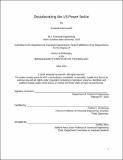| dc.description.abstract | As the second highest national emitter, the US has the opportunity, and responsibility, to reduce emissions and mitigate the impacts of climate change. The power sector has been identified as the linchpin in our national decarbonization strategy, with high electrification goals for the other sectors. As of 2022, the power sector was responsible for more than a quarter of annual emissions. As electrification increases, the importance of decreasing the emissions and emissions intensity of electricity production grows. This thesis explores the challenges and opportunities of decarbonizing the US power sector. Two models were built to complete this analysis: Ideal Grid (IG) which is a greenfield capacity expansion and economic dispatch model, and Evolving Grid (EG), which is a brownfield capacity expansion and economic dispatch model. These models are an especially novel addition to the current arsenal of publicly available capacity expansion models because they include embodied emissions, in addition to the industry-standard consideration of power plant tailpipe emissions from fossil fuel combustion. Nine regions of the contiguous US are represented in these models. First, IG is used to highlight regional decarbonization challenges. Regions with significant land available for variable renewable energy (VRE) buildout and strong wind resources had the cheapest paths to a clean grid. Also, hydropower resources play a significant role. At deep decarbonization levels, the need for long-duration energy storage (like pumped hydropower storage) increases. The role of embodied emissions is explored, showing that as fossil-fuel consumption decreases and VRE penetration increases, they become nonnegligible. To most effectively reduce system emissions, embodied emissions should be accounted for. Next, fusion is integrated into the model to demonstrate its potential role. Assuming a $8,500/kW CAPEX, fusion is not economically competitive unless a carbon constraint is applied. But, at deep decarbonization levels, fusion is prominent in all regions. EG shows that intermediary decarbonization goals before 2050 play a pivotal role in determining fusion adoption and overall fleet composition. Lastly, the versatility and value of presented models is demonstrated by outlining other potential applications. | |
